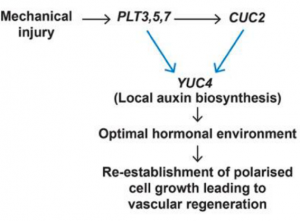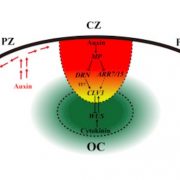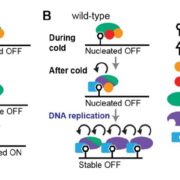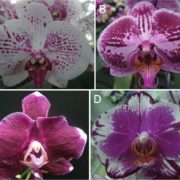A feedforward loop controls vascular regeneration and tissue repair through local auxin biosynthesis (Development)
 Plants are constantly exposed to biotic and biotic stresses that can cause tissue damage, and, as a response, plants have evolved remarkably plastic regenerative mechanisms in response to wounding. Although some genes required for regeneration have been identified in the Arabidopsis root context, most notably PLETHORA (PLT) genes, the molecular players required for wound repair in aerial organs are mostly unknown. Here, Radhakrishnan et al revealed that PLT3, PLT5 and PLT7 (PLT3,5,7) transcription factor genes that are required for in vitro shoot regeneration, among other processes, as well as the closely related AINTEGUMENTA gene, are key players necessary for tissue repair and vascular regeneration in aerial organs. Through combinations of loss-of-function mutants, reporter and overexpression lines, the authors dissected a feedforward loop circuit that drives regeneration of vascular tissue in response to injury. The authors demonstrated that, in response to injury, PLT3,5,7 directly activate transcription of CUC2, a known regulator of PIN1 polarity and auxin distribution. The PLT-CUC2 module then synergistically activates transcription of the auxin biosynthesis gene YUC4. This feedforward loop creates an optimal hormonal environment that promotes tissue repair and vascular regeneration through PIN1 polarization and induction of vascular identity by AINTEGUMENTA. This study shows how stem cell regulators identified in other contexts can also serve as regulatory triggers in other developmental processes. (Summary by Jesus Leon) Development 10.1242/dev.185710
Plants are constantly exposed to biotic and biotic stresses that can cause tissue damage, and, as a response, plants have evolved remarkably plastic regenerative mechanisms in response to wounding. Although some genes required for regeneration have been identified in the Arabidopsis root context, most notably PLETHORA (PLT) genes, the molecular players required for wound repair in aerial organs are mostly unknown. Here, Radhakrishnan et al revealed that PLT3, PLT5 and PLT7 (PLT3,5,7) transcription factor genes that are required for in vitro shoot regeneration, among other processes, as well as the closely related AINTEGUMENTA gene, are key players necessary for tissue repair and vascular regeneration in aerial organs. Through combinations of loss-of-function mutants, reporter and overexpression lines, the authors dissected a feedforward loop circuit that drives regeneration of vascular tissue in response to injury. The authors demonstrated that, in response to injury, PLT3,5,7 directly activate transcription of CUC2, a known regulator of PIN1 polarity and auxin distribution. The PLT-CUC2 module then synergistically activates transcription of the auxin biosynthesis gene YUC4. This feedforward loop creates an optimal hormonal environment that promotes tissue repair and vascular regeneration through PIN1 polarization and induction of vascular identity by AINTEGUMENTA. This study shows how stem cell regulators identified in other contexts can also serve as regulatory triggers in other developmental processes. (Summary by Jesus Leon) Development 10.1242/dev.185710
[altmetric doi=”10.1242/dev.185710″ details=”right” float=”right”]









